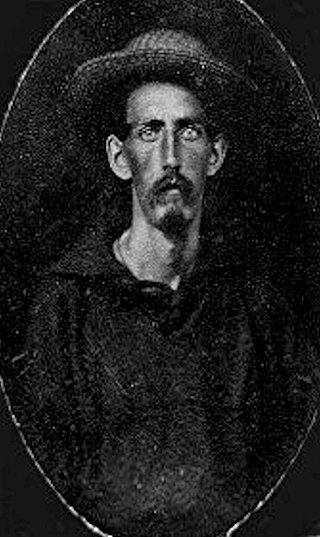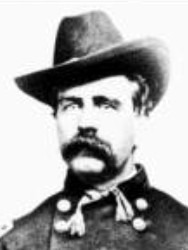
John Gordon Morrison served in the American Civil War, receiving the Medal of Honor in 1862.
Carrsville is a census-designated place (CDP) in Isle of Wight County in the Hampton Roads region of southeastern Virginia in the United States. The population as of the 2010 Census was 359. The town is named for Jesse Carr, whose family had long roots in Isle of Wight County. Jesse Carr died in the place that would later bear his name.

During the American Civil War, the State of Ohio played a key role in providing troops, military officers, and supplies to the Union army. Due to its central location in the Northern United States and burgeoning population, Ohio was both politically and logistically important to the war effort. Despite the state's boasting a number of very powerful Republican politicians, it was divided politically. Portions of Southern Ohio followed the Peace Democrats and openly opposed President Abraham Lincoln's policies. Ohio played an important part in the Underground Railroad prior to the war, and remained a haven for escaped and runaway slaves during the war years.

The 1st West Virginia Cavalry Regiment served in the Union Army during the American Civil War. Although it started slowly, it became one of the most active and effective of the West Virginia Civil War regiments—and had 14 Medal of Honor recipients, the most for any West Virginia regiment during the war. It was originally called the 1st Virginia Cavalry, not to be confused with the Confederate 1st Virginia Cavalry. Some reports added "Union," "Loyal" or "West" when identifying this regiment. After the Unionist state of West Virginia was officially admitted to the Union in 1863, the regiment became the 1st West Virginia Cavalry Regiment. The National Park Service identifies it as the 1st Regiment, West Virginia Cavalry.

George Crawford Platt was an Irish American who served with the federal army of the United States during the American Civil War. A private with Troop H of the 6th U.S. Cavalry, he was awarded the Medal of Honor, America's highest award for valor in combat, for protecting the American flag in hand-to-hand combat near Fairfield, Pennsylvania, during the Battle of Gettysburg on July 3, 1863.

Richard H. Cosgriff, Sr., was a Union Army soldier in the American Civil War and a recipient of the United States military's highest decoration, the Medal of Honor. An Irish immigrant, his family eventually settled in Wisconsin, where he would spend most of the rest of his life. Enlisting in an Iowa cavalry regiment, he was awarded the Medal of Honor for capturing a Confederate battle flag during an engagement in the last month of the war. After returning to Wisconsin, he worked as a businessman in the lumber and printing industries until his death at age 64.
Hispanics in the American Civil War fought on both the Union and Confederate sides of the conflict. Not all the Hispanics who fought in the American Civil War were "Hispanic Americans" — in other words citizens of the United States. Many of them were Spanish subjects or nationals from countries in the Caribbean, Central and South America. Some were born in what later became a U.S. territory and therefore did not have the right to U.S. citizenship. It is estimated that approximately 3,500 Hispanics, mostly Mexican-Americans, Puerto Ricans and Cubans living in the United States joined the war: 2,500 for the Confederacy and 1,000 for the Union. This number increased to 10,000 by the end of the war.

Henry Capehart was a surgeon and officer in the U.S. Cavalry during the American Civil War. He received the Medal of Honor for saving the life of a drowning soldier while under fire at Greenbrier River, West Virginia, on May 22, 1864.
John Vale was a member of the Union Army during the American Civil War. He received the Medal of Honor in 1897 for his bravery on February 15, 1863, at Nolensville, Tennessee.
Thomas A. Anderson was a United States soldier and native of Pennsylvania who fought with the Union Army as a corporal in Company I of the 1st West Virginia Cavalry during the American Civil War. He was awarded his nation's highest award for valor, the U.S. Medal of Honor, for capturing the flag of a Confederate regiment during the Battle of Appomattox Station on April 8, 1865. The award was conferred on May 3 of that same year.

Between 1861 and 1865, American Civil War prison camps were operated by the Union and the Confederacy to detain over 400,000 captured soldiers. From the start of the Civil War through to 1863 a parole exchange system saw most prisoners of war swapped relatively quickly. However, from 1863 this broke down following the Confederacy's refusal to treat black and white Union prisoners equally, leading to soaring numbers held on both sides.

Wilmon Whilldin Blackmar was a United States military officer who fought with the Union Army as a member of the 15th Pennsylvania Cavalry and the 1st West Virginia Cavalry during the American Civil War. He received his country's highest award for bravery during combat, the U.S. Medal of Honor, for his "extraordinary heroism" for taking the initiative, during a critical stage of the Battle of Five Forks on April 1, 1865, to lead a successful advance upon the enemy while fighting with the 1st West Virginia Cavalry. His award was conferred on October 23, 1897.
William Downey was an Irish soldier who fought in the American Civil War. Downey received the United States' highest award for bravery during combat, the Medal of Honor, for his action at Ashepoo River, South Carolina on May 24, 1864. He was honored with the award on January 21, 1897.

James Dunlavy was an American soldier who fought for the Union Army in the American Civil War. Dunlavy received the Medal of Honor for capturing Confederate Major General John Sappington Marmaduke at the Battle of Mine Creek on October 25, 1864.

Alexander Calvin Elliott was a United States soldier who fought with the Union Army during the American Civil War as a sergeant with Company A of the 1st Pennsylvania Cavalry. He received his nation's highest award for valor, the U.S. Medal of Honor, for his actions at Paines Crossroads, Virginia on April 5, 1865. That award was conferred on May 3, 1865.

John Mitchell Vanderslice was a United States soldier who fought for the Union Army during the American Civil War as a member of the 8th Pennsylvania Cavalry. He received his nation's highest award for valor, the U.S. Medal of Honor, for being the first man to reach the rifle pits of the Confederate States Army during a charge made by his regiment on CSA fortifications in the Battle of Hatcher's Run, Virginia on February 6, 1865.
The 13th Pennsylvania Cavalry Regiment was a cavalry regiment that served in the Union Army during the American Civil War.

Michael A. Sowers was a private in the United States Army who was awarded the Medal of Honor for gallantry in the American Civil War. Sowers was awarded the medal on 16 February 1897 for actions performed at the Battle of Stony Creek Depot in Virginia in 1864.

William Mathews (1844-1928) was an American soldier who fought in the American Civil War. Mathews enlisted in 1861 at age 17 in Baltimore, Maryland, under the name Henry Sivel. He served during the Civil War in Company E, 2nd Maryland Volunteer Infantry, rising from private to commander of Company E. He was promoted to sergeant on May 15, 1863, and to first sergeant on June 22, 1863. On January 1, 1864, he reenlisted as a veteran volunteer, retaining his first sergeant rank. He was commissioned as a first lieutenant October 24, 1864, and a captain June 27, 1865. He was wounded twice, and captured once but quickly paroled. He mustered out of service on July 17, 1865.

Henry C. Slusher was a private in the United States Army who was awarded the Medal of Honor for actions performed on 11 September 1863 at Moorefield, West Virginia.













